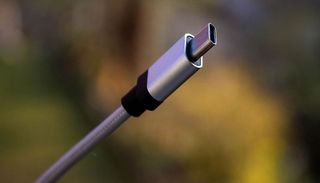There's officially a new and faster USB standard, now we wait for actual devices
And wait, and wait, and wait...

There a strong argument to be made for USB connectivity being the most important thing to happen to PCs—it at least ranks right up there. So the announcement of a new "USB4" standard should be exciting. In some ways it is, but at the same time, the USB landscape has become needlessly confusing.
More on that in a minute, but first let's talk about the spec. We wrote about USB4 in March, when the USB Implementers Forum (USB-IF) first announced the standard. At the time, we were optimistic it would clear up the confusion with regards to the many USB specs that now exist.
Now six months later, USB-IF has published an official specification (PDF). This means USB4 is now finalized, and manufacturers can begin building devices and cables around the spec. So, what exactly is USB4?
It's basically a modified version of Thunderbolt 3. The key characteristics include the following:
- Two-lane operation using existing USB Type-C cables and up to 40Gbps operation over 40Gbps certified cables
- Multiple data and display protocols that efficiently share the maximum aggregate bandwidth
- Backward compatibility with USB 3.2, USB 2.0 and Thunderbolt 3
USB4 doubles the aggregate bandwidth of USB and enables multiples simultaneous data and display protocols. It essentially paves the way for a single cable/standard to rule them all.
That's all well and good, except there may be multiple versions of USB4. An engineer who is apparently familiar with USB-IF's plans told TechRepublic there will be "different grades" of USB4—a certified cable would be able to support two 4K feeds at 60fps apiece. This could also mean faster external graphics enclosure solutions.
"Once the specifications are released, there will be a new round of confusion," the developer said. "It's going to be USB4, but you have to qualify what USB4 means, because there are different grades. USB4, by definition, has to be [at least] Gen 2×2, so it will give you 10Gbps by 2, that's 20Gbps. There's going to be USB4 Gen 3×2, which is 20Gbps per lane. 20 by 2 will give you 40Gbps."
The biggest gaming news, reviews and hardware deals
Keep up to date with the most important stories and the best deals, as picked by the PC Gamer team.
Things have already gotten a little out of hand in the USB space. Multiple speed grades and newer standards have resulted in USB-IF going back and renaming past standards. Here's how things have evolved:
- USB 1.1 ---> still USB 1.1 (Full Speed)
- USB 2.0 ---> still USB 2.0 (High Speed)
- USB 3.0 ---> USB 3.1 Gen 1 ---> USB 3.2 Gen 1 (SuperSpeed)
- USB 3.1 Gen 2 ---> USB 3.2 Gen 2 (SuperSpeed 10Gbps)
- USB 3.2 Gen 2x2 (SuperSpeed 20Gbps)
Now we could potentially have USB4 (no space) Gen 2x2 and Gen 3x2. Hopefully the past standards remain as-is, rather than another round of renaming. On the bright side, USB4 will stick to a single connector, that being USB-C.
As for when we will see USB4 devices, they will start showing up next year. However, expect a slow roll out. The widespread use of USB Type-A connectivity has made the transition to Type-C connectors relatively slow, and I don't anticipate a sudden shift in 2020.
Paul has been playing PC games and raking his knuckles on computer hardware since the Commodore 64. He does not have any tattoos, but thinks it would be cool to get one that reads LOAD"*",8,1. In his off time, he rides motorcycles and wrestles alligators (only one of those is true).
Most Popular







